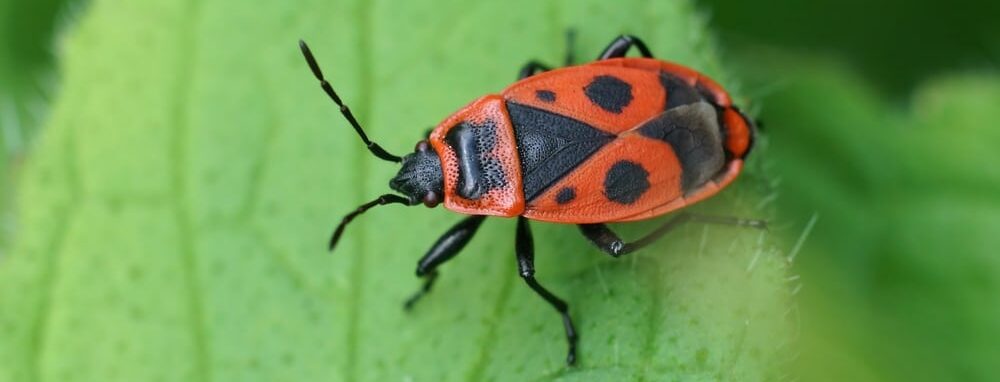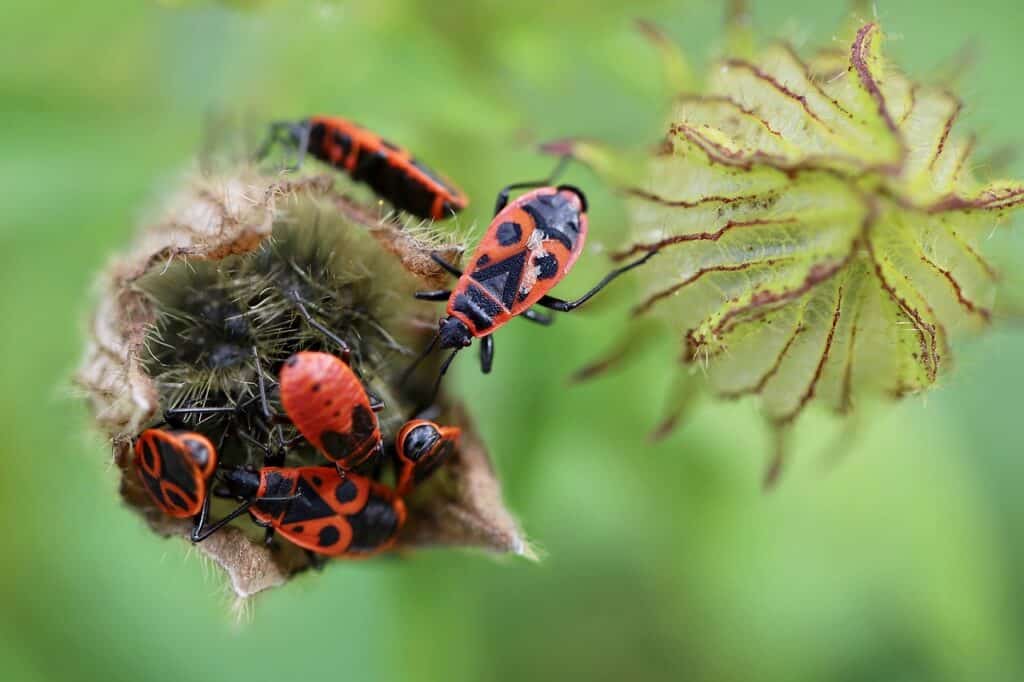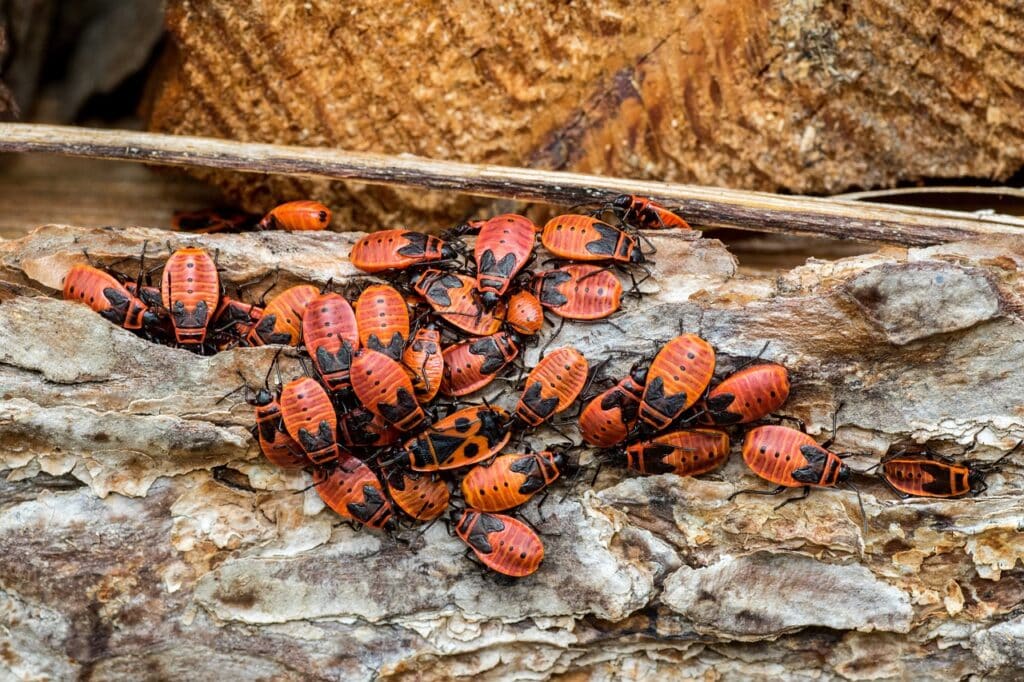Log in or create new account to save this product to your wishlist.

Firebugs in the Garden: What now?!
Firebugs in your garden? SPOILER ALERT - they're benign! They won't harm you or your garden. Find out how these interesting bugs contribute to your garden's ecosystem.
🌱 All important maintenance moments for your lawn during the year. Leave your email and we will send you the lawn calendar for free.
Enter your email
Receive the lawn calendar in the mail
Enjoy a green lawn all year round!

- Order by 2PM = shipped today
- 250.000+ satisfied customers!
- 60 day satisfaction guarantee
Until relatively recently, the common firebug wasn’t commonly found in the UK. But now, you can find these European settlers almost everywhere you go: in the garden, park, and even living in and on trees.
- The firebug family
- Recognising firebugs
- The Firebugs’ favourite hiding places
- Firebugs in the garden: harmful or helpful?
- Are firebugs poisonous?
- The firebug’s role in your garden’s ecosystem
- What to do if your patio gets infested?
- Firebugs are not that bad!
- FAQs
These tiny insects may look dangerous with their blood-red and black shells, but they’re actually harmless to humans and feed solely on seeds, so they’re unlikely to nibble on your plants.
So, what should you do if you discover a firebug infestation in your garden?
Find out here.
The firebug family
The common firebug (Pyrrhocoris apterus) belongs to the Pyrrhocoridae family. And while they may look like beetles, they’re not. They’re effectively relatively benign garden insects.
Recognising firebugs

It’s easy to identify a firebug because they look distinctive, with their bright red or orange backs and symmetrical black patterned markings.
The black pattern varies depending on the specific species, but many have a striking X pattern across their back, while others have stripes or spots.
The firebug’s body is flat and oval, and they have six legs and two antennae. They have a proboscis with which they eat plant seeds, aphids, and the corpses of their own species! So, firebugs in your garden could help control aphid infestations.
Ultimately, firebugs are generally benign, posing very little threat and could be considered a valuable part of your garden’s ecosystem.
The Firebugs’ favourite hiding places

Firebugs tend to congregate in large numbers, appearing principally during the warmer months of the year. While they’re active, firebugs constantly search for food and mates.
You’ll find these harmless critters in sunny and warm areas of your garden, especially in walls that capture the sun’s heat during the day, offering a warm haven in the evening.
You’ll also discover firebugs underneath dead leaves and rotting wood.
Firebugs spend most of the day looking for food and lay eggs close to food sources. The young nymphs remain close to their parents until they’re fully grown.
Firebugs in the garden: harmful or helpful?
Well, this is a refreshing article to write because — for a change — we’re suggesting living with your firebug friends rather than ridding them from your garden. Firebugs eat seeds and dead organic matter, so they’re actually playing an essential role in your garden.
Firebugs can help control aphids and even molluscs such as snails. They sometimes drink the sap from plants, which can cause some damage, but typically, they won’t cause a lot of havoc.
Their favourite plant is the mallow — whenever there’s a mallow in the garden, firebugs will feed on its seeds and leave your other plants alone.
Ultimately, firebugs contribute to the decomposition process required to clear dead organic matter, so they’re helpful and can help return nutrients to the soil.
Are firebugs poisonous?
They may look it, but firebugs aren’t toxic. They’re actually utterly harmless to humans and animals. They don’t bite, and they don’t produce venom.
Their bright colour primarily serves to deter predators, who see their colouring as a warning of poison. However, they’re not toxic to birds who enjoy a little firebug snack now and then.
The firebug’s role in your garden’s ecosystem

Firebugs benefit your garden’s ecosystem in the following ways:
They break down dead plant parts and rotting wood, leaving plenty of nutrients behind that maintain your soil’s health
They’re an essential source of food for other animals. Birds, reptiles, and amphibians, such as frogs, have learned that firebugs offer a nutritious meal despite their threatening appearance.
What to do if your patio gets infested?
While firebugs aren’t hazardous, they might freak out the more squeamish among us. So, if you spot some in your garden and don’t want them there, simply pick them up and move them to another place. Or use a soft brush and sweep them up and drop them off somewhere else.
You can kill them with pesticides, but why would you?
Firebugs are not that bad!
These misunderstood creatures pose absolutely no threat, so I suggest learning to live with them as equals. Sure, move them if you find their presence uncomfortable, but they won’t harm you, your pets, or your garden plants — so enjoy their presence as part of a rich ecosystem.
FAQs
They not! Firebugs pose very little threat to human, animal or plant life, so if you spot firebugs, leave them be. They may look dangerous, with their red backs and symmetrical markings, but they’re entirely benign garden visitors! Live and let live, I say!
No. They’re non-toxic and don’t bite. Firebugs don’t pose a threat to humans, pets, or plant life. They feed on seeds and enjoy a symbiotic relationship with the plants that provide them.
Firebugs enjoy warm, sunny spots in your garden, but you’ll also find them underneath leaves and by rotting wood. They feed on the remaining juices of dead plant parts, so they’re a valuable contributor to your garden’s essential decomposition process.
Any questions?
I hope you’ve enjoyed reading about our friends, the firebugs, but if you have any questions, get in touch.
Or check our comprehensive lawn and garden Help & Advice section for a vast selection of how-tos, step-by-step guides, and gardening information.
Thanks for reading
-
Orchids: A Complete Guide on How to Care for ThemWant to give your orchid the best possible care? Discover essential tips from placement to watering and pruning. Learn everything you need to know!Read more
-
Growing Wisteria Made Simple: From Planting to Perfect BloomsWith blossoms like a purple waterfall, Wisteria sets an almost magical and colourful mood. If you want to grow this beauty in your garden, you’ll need a bit of patience. Don’t worry, it will most definitely pay off.Read more
-
How to Build a DIY Greenhouse: A Practical Guide for Smart SpendersImagine extending your growing season throughout the year, nurturing tender plants regardless of the weather, and creating a personal garden sanctuary. This is precisely what a DIY greenhouse offers you. Let’s learn how to build one.Read more
-
How to Grow Eucalyptus in British GardensWith a little love and care, eucalyptus trees can thrive in English gardens. Since they don’t germinate well without proper help, there are not considered invasive. So, there is no reason not to plant them if you enjoy their looks.Read more
-
Transform Your Garden with All-Year-Round Flowering PlantsDid you know you can enjoy blooming flowers even in January? With the right selection of all year round plants, there’s no need to wait until spring to add some colour to your garden.Read more
-
How to Create a Butterfly Garden: A Simple Guide for British GardensThe UK's butterfly population includes 59 different species. These beautiful winged creatures face a steady decline because of habitat loss, pollution and changing weather patterns. Your garden can become a vital link between nature reserves and natural habitats. Let’s explore how.Read more
-
Volcanic Rock Dust for Your Garden—Application and TipsDid you know that volcanic rock dust is a brilliant organic soil improver? This article explains exactly what it's good for and how to use it properly.Read more
-
How to Use Landscape Fabric ProperlyIf weeds or erosion in your garden are troubling you, landscape fabric might be the solution. We’ll explain how and when to use it properly, just keep on reading.Read more
Leave a comment
Your answer will be displayed on the site and the interested party will be notified by email.
Leave a comment
Have a question or want to share your experience? Leave us a comment.

- Order by 2PM = shipped today
- 250.000+ satisfied customers!
- 60 day satisfaction guarantee

- Order by 2PM = shipped today
- 250.000+ satisfied customers!
- 60 day satisfaction guarantee

🌱 All important maintenance moments for your lawn during the year. Leave your email and we will send you the lawn calendar for free.
Enter your email
Receive the lawn calendar in the mail
Enjoy a green lawn all year round!






















Comments (0)
There are no comments yet. Well then, what are you waiting for to
Be the first to write your comment!inaugurate this pretty page?
Do you have some comments?